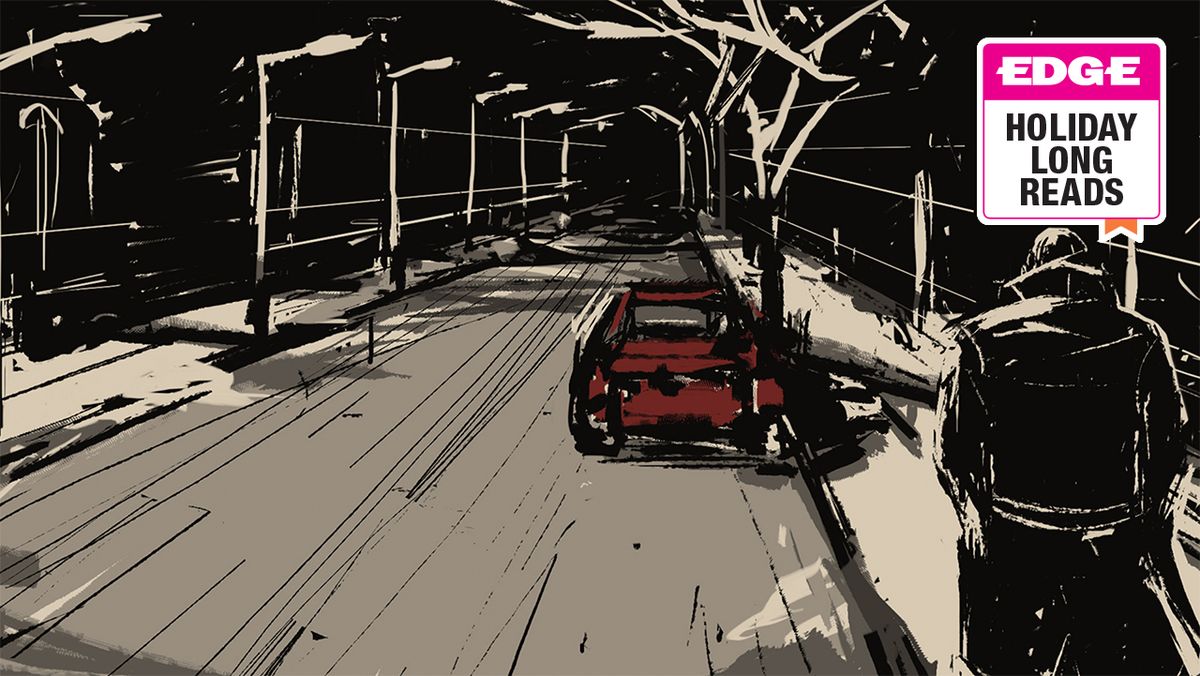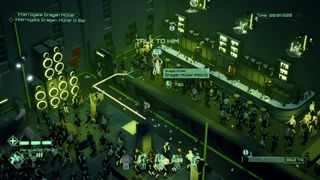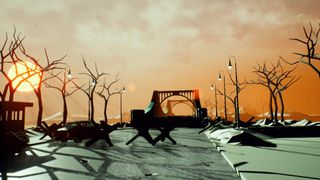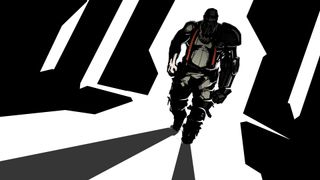In our divided world, a new wave of games use time-travel discos and bus rides to honour a pivotal era in history
Thirty years after the Wall fell, games are exploring what it means to remember a divided Germany

Rain is falling on the morning of November 14, 1989, as the 08.15 to Rathaus Spandau pulls away from Falkensee Bahnhof. A vertical blade pulls across the sheer windscreen, neatly dividing the glass into wet and not-wet. Cobbles beneath the wheels rattle the frame of the bus until it reaches the main road, where the percussion becomes irregular, kicking in at intervals as the wheels dip in and out of potholes. These pockmarked streets are shared with the Trabants, the boxy sedans which had seemed so modern in the 1950s; now, in 1989, their missing turn signals make them an antiquated hazard. Nobody gets off at the last stop before the border checkpoint, a fresh breach in the Wall that opened up for traffic just yesterday. For decades, passing through could have meant imprisonment or death. But at a press conference four days ago, the GDR’s governing party announced an end to travel restrictions between East and West Germany. “As far as I know, it takes effect immediately,” East Berlin boss Günter Schabowski had said. “Without delay.”

This feature first appeared in Edge Magazine. If you want more great long-form games journalism like this every month, delivered straight to your doorstop or your inbox, why not subscribe to Edge here.
He was wrong – the party had intended the border to open up the following day – but it didn’t matter. Hours after his comments were broadcast, 10,000 people were at the Bornholmer Bridge checkpoint in Berlin. In the absence of orders, the border guards relented, but stamped the passports of those at the front of the queue in such a way as to deny them re-entry. It was a final, impotent act by a state still working to keep tabs on its people, even after the point it had lost the capacity to wield that coveted information against them. Cardboard signs sit in the windows of the Rathaus Spandau bus, hurried and temporary. Public transport routes were one of the first things to change when construction of the Berlin Wall began in 1961, and when it fell they quickly reverted. At the end, buses announced the return of personal freedom in all its everyday mundanity.
This journey was recreated in detail for OMSI2, the German simulator which meticulously models the experience of Berlin bus drivers between 1986 and 1994. Such is its verisimilitude that Isaac Ashdown, a game developer and resident of the city since 2008, recognises his own regular ride from Spandau across the former border. “That’s actually a route I take fairly often, because my favourite lake in the city is one that was on the border,” he says. “It went right down the middle. I go there with my dog in the summer.” It’s one of many ways the city’s history has revealed itself to Ashdown. “It’s not something I really put any thought into before,” he says. “I moved here for the gay scene and because I got a pretty good job.” By the time he left that job, after the cancellation of Yager’s Dead Island 2, he was fascinated by the way in which the line through Berlin had become visible to him, even in the Wall’s absence. “You cross the street and, suddenly, the architecture is quite radically different, a lot more Brutalist in the east,” he says. “That includes urban planning: in the west they ripped up all the tram lines and replaced them with car-friendly roads. And the other thing is the people.”
"All Walls Must Fall is set in a divided Germany where both sides on the front of the Cold War have become only more entrenched, thanks to the development of time-travel technology that allows agents to counter each others’ moves in retrospect"
West Berlin is home to Turkish communities recruited after 1961 as Gastarbeiter (guest workers). By contrast, East Berlin areas like Lichtenberg – which housed the headquarters of the Stasi, the German Democratic Republic’s sprawling intelligence service – are distinguished by their Vietnamese population, started during socialist migration in the 1980s. Those old capitalist and communist battle lines are still apparent, even in the makeup of the city’s population. It’s perhaps then not surprising that Ashdown and two of his former Yager colleagues, artist Rafal Fedro and designer Jan David Hassel, imagined a game world where the Berlin Wall still existed into 2089. All Walls Must Fall, a tactics and espionage game set in the nightclubs of a future GDR, is set in a divided Germany where both sides on the front of the Cold War have become only more entrenched, thanks to the development of time-travel technology that allows agents to counter each others’ moves in retrospect. The trio of developers, known as Inbetween Games, added another ‘S’ to the Stasi to create STASIS.
There’s something deeply scary about the idea of these notorious secret-scribblers cataloguing not only a citizen’s past, but their future as well. In the GDR’s 40 years, the Stasi produced a number of files equivalent to all of Germany’s records since the Middle Ages. How full would their filing cabinets have been after 140? That fear becomes palpable in the dialogue sequences of All Walls Must Fall: interrogations in which your STASIS officer flirts or threatens their way to information about an imminent nuclear attack. “Ahh... you must be that suspect I saw so much about,” you might bluff. “I know what you’ll do tonight. Doesn’t look good. At all.” Ashdown explains: “We wanted these people in the clubs to feel helpless, because the authority is constantly rewinding the clock and changing what’s happened to them.”
Power exerts control through surveillance

This state of temporal helplessness captures the MO of the Stasi more perfectly than a strictly historical representation ever could. The GDR’s enforcers tortured people the traditional way, yes – but by the 1970s they had developed ways to control people that didn’t leave bruises. In a process codified as Zersetzung, or “degradation”, they subtly undermined targets’ self-confidence, secretly wrecking careers and relationships. Their most effective manipulation took place in bland interrogation rooms, where they unpacked the intimate details of their victims’ lives – in one case, reading a citizen’s love letters to an Italian boyfriend back to them. Zersetzung often enabled the Stasi to recruit informers, but was designed principally to ‘switch off’ their enemies – removing the light from behind their eyes.
The resulting nihilism is visible everywhere in All Walls Must Fall. Drawing from the underground punk-rock scene of East Germany and the modern-day clubs of Berlin, Inbetweengames created a Berlin whose people have decided nothing matters. There’s an apocalyptic edge to the hedonism of the procedurally generated clubs that make up the levels, where patrons dance nude and slack-bodied, and violence is only ever a misjudged compliment away. “I like to go out and party,” Ashdown says. “But there are definitely people you meet in that scene, generally who are addicts of some kind, who have given up.” Even your STASIS agent is utterly at the mercy of his own handler, teleported back and forth through the game’s timeline, unable to verify which of his experiences of the night still stand and which have been reset. “Time-travel stories are a classic sci-fi trope, like Minority Report,” Ashdown says. “Here they’re using it not to prevent crime, but just to make you feel like shit.”
Sign up to the 12DOVE Newsletter
Weekly digests, tales from the communities you love, and more
Although this fictionalised GDR has clearly recognised the benefit of letting its citizenry blow off steam, there are echoes of its real-world culture of restriction, too. All Walls Must Fall smartly blends the terminology of covert gay slang – ‘friend of Dorothy’ – with the idea that in this world, The Wizard Of Oz would constitute an “illegal holo”. In the real East Germany, party-approved television was so notoriously uninformative that the area around Dresden which couldn’t be reached by West German TV signal was known as the ‘Valley Of The Clueless’. And in November 2089, the ways people sidestep the state’s prohibition are clearly still very much alive. There’s something about this mixing of the historical with the contemporary in All Walls Must Fall – even the ‘turbo’ Trabant that awaits you outside each mission – that makes the danger of the Wall and the Stasi felt. It wipes away the sepia and replaces it with neon.
Heed the warnings of history

That’s only appropriate. Even now, Germans make reference to the ‘wall in the mind’ to account for the differing cultural identities of Easterners and Westerners. But for some victims of the regime, the Wall still exists as a terrifying and non-abstract possibility. In the acclaimed non-fiction book Stasiland, Anna Funder interviews a mother, Sigrid Paul, who was separated from her sick baby by the Wall until he became an adult. “Who would have thought that a wall could be built?” Paul asks. “That was impossible! And who would have thought at the end that it might ever fall? That was also impossible!” It follows, then, that a divided Germany might be possible again. What All Walls Must Fall fights is the human tendency to put the past behind glass – to consider ourselves safe from its mistakes simply because they are over.
There’s a Wall baby at the centre of another game that tackles life in East Germany with an arresting sense of urgency. Jalopy is the fictional story of three Turkish immigrants who move to East Berlin for work, only to be wrenched apart for the better part of their lives. On the August 1961 weekend when the GDR closes the Berlin border, Hasaan and his wife are unfortunate enough to be on the Western side looking for work. They’re permanently cut off from their young child in East Berlin, who is left in the custody of their friend, Lutfi. This slow-burn tragedy forms the backdrop of Jalopy’s 1990 road trip – in which you, the Wall baby grown up, accompany Uncle Lutfi out of Berlin towards Turkey, to bury your father’s ashes and, afterwards, meet your mother in West Germany for the first time in nearly three decades. It’s a tale scattered across the state-redacted documents and tear-stained letters carried in Lutfi’s case, which you can only read while he sleeps in motel rooms. But the broader tale of a falling Iron Curtain is more easily spotted.
Throughout Jalopy you take care of an ancient Laika 601, a fictionalised Trabant, which threatens to break down at every juncture. It performs admirably: not as a vehicle, but as an allegory. In its dying days, East Germany was run by old men who refused to acknowledge the change sweeping the Eastern Bloc, even when it came from the mouth of Mikhail Gorbachev himself. Driving this knackered old symbol of the state, waiting for the wheels to literally fall off, you can feel it. “None of that’s really a credit to me,” Jalopy creator Greg Pryjmachuk says. “The fraternal socialist states were full of this symbolism in all aspects of day-to-day life. We’ve just had the Chernobyl TV show blow up on our screens because the control rods were made of boron tipped with graphite – because it was a cost saving. If you’re looking into this period you’re going to be tripping over this stuff.”

Jalopy’s open road, dotted with forests, lighthouses and concrete highways, represents connection – just as it did for the people of Germany when travel restrictions opened up in 1989. “Not just from one place to another, but whoever you’re travelling with,” Pryjmachuk says. “There’s the old adage that ‘Life’s a journey, not a destination’, and it’s really just a disconnected way of saying, ‘Enjoy your time together.’” Your constant companion on Jalopy’s journey is Uncle Lutfi. He tells his stories the way elderly family members tend to – disjointedly, as if absent-minded or struggling to access old details and emotions. At times he speaks with fondness for the GDR, a place that gave him a clear role and a sense of shared national purpose. This is what the Germans refer to as Ostalgie, a portmanteau that folds in the German word for ‘east’. “I just wanted to try and make a game with a more honest, humane focus to its politics,” Pryjmachuk says. “The accounts people have after East Germany are endearing.” Not for Jalopy the espionage drama of the Cold War; no prisoner exchanges on the Bridge Of Spies, the famous Glienicke crossing between Berlin and Potsdam.
Like OMSI2, Jalopy finds its power in the mundane, and a kind of honesty through the simulation genre. Pryjmachuk was hesitant even to include the border checkpoints that punctuate your ride from East Berlin to Istanbul, not wishing to join the list of game developers with ‘AK47 model’ on their CV. But there’s power, too, in portraying the stricture of the failing Bloc. Sitting, eyes forward, as the guard rummaging in your boot shakes the car back and forth on its suspension, the sudden constraint is shocking. “You’ve got this stark contrast going from the freedom of choice on the open road to doing what the guards tell you,” Pryjmachuk says. “The player has to make some compromises if they want to continue to exercise their freedoms.”
"Stasiland writer Anna Funder has described East Germany as a bell jar which, although lifted once the Wall came down, left everyone in place"
These border searches can be tense indeed, since you’re often smuggling contraband between petrol stations. Although you’re subsidised by Uncle Lutfi, you have to engage in capitalism to keep the car going, stripping abandoned Laikas for parts to exchange for engine oil and tyre repair kits. It’s another strong metaphor for the ideological failings of East Germany, which enjoyed the option of selling dissidents to the West, solving its political problems at a profit. “When I come to think of why this political system failed where it did,” Pryjmachuk says, “I tend to think of what [Mao successor] Deng Xiaoping said: ‘It doesn’t matter if the cat is black or the cat is white. So long as the cat catches mice.’ Whether you’re being subsidised by your uncle, or selling wine at a profit, it doesn’t matter so long as the wheels are rolling.”
It’s the contradictions of East Berlin that Pryjmachuk found so irresistible when picking a setting for Jalopy. The Wall, he points out, was built with supplies sold to the GDR from West Berlin – the very border built to protect East Germany from the economic drain of young professionals leaving the country. And the Fernsehturm, Berlin’s TV tower built to show that socialist power was greater than God, has its view blinded by a light flare in the shape of a cross on sunny days. “People have a tendency to hurtle towards zeal because it’s easily digestible,” Pryjmachuk says. “I think contradictions probably keep us human.”
Stasiland writer Anna Funder has described East Germany as a bell jar which, although lifted once the Wall came down, left everyone in place. Victims of the state who chose not to move away continued to live alongside their Stasi abusers, as well as friends and colleagues who had informed on them. At one time, full-time collaborators who passed information to the Stasi made up one in every 63 citizens; including occasional informers, the total rises to one in every 6.5. The volatility of the spies and spied upon living together was exacerbated by a 1992 government ruling that made Stasi records open to the public. As a former East German, it is your right to visit the Stasi Records Agency and read the files that were made about you. The decision provided important catharsis for those impacted by Zersetzung – the ability to confirm suspicions about why they were turned down for a job, or who sabotaged a car. But it also let East Germans know exactly who had betrayed them.

German reunification, then, has been a process of forgetting in order to get along. But it’s left the world at risk of forgetting the people of East Germany and their stories. “People don’t talk about the Stasi, for example, as openly as they talk about what it was like not to pay for public transport,” Ashdown says. Ashdown, who lives about 300 metres from the Wall, doesn’t need his memory of the GDR and its people jogged. In the winter when the trees are bare, he can see its most potent reminder from his window. But for those too young or distant to remember, perhaps these games can pull East Germany from the history books and make it real again – despite the fact that confronting that reality is almost a rebellious act.
All Walls Must Fall was designed to draw uncomfortable contemporary parallels to the past – from its provocative title, to its concept art, which replaces the GDR-era figures in the Wall’s famous ‘fraternal kiss’ graffiti with Trump and Putin. But Ashdown isn’t convinced Inbetweengames has converted anyone. The far-right complaints the studio braced for never arrived, and the audience that did play the game was politically conscious before it released. Pryjmachuk, similarly, thinks it would be arrogant to assume that Jalopy has changed anybody’s outlook on Trump’s border wall or the West Bank. But these games have purpose enough: not to alter today, but to honour the suffering of ordinary East Germans over four decades. “I think it’s important to tell it from the perspective of the Berlin Wall, because these things did happen,” Pryjmachuk concludes. “These people deserve to be remembered.”
Only in OMSI2 do the stories of ordinary East Germans reach a non-politicised audience, one not already steeped in its history. The work of two Berlin natives, Marcel Kuhnt and Rüdiger Hülsmann, the sim is not built to evoke Cold War tension or Stasi cruelty. It’s merely a fond recreation of the pair’s bus rides home after school, on the fake-leather seats of West Berlin’s distinctively beige double-decker, the Man SD 200. Its players come to hear the roar of diesel engines, not messages of freedom – but perhaps they get something else into the bargain. Once the 8.15 to Rathaus Spandau passes through the membrane into the West, it’s as if a filter has been lifted. The cars are suddenly multicoloured. The streets are wider, and the landscape gains a new vertical dimension that speaks of wealth. As the tarmac smooths out, the rattle diminishes, giving way to two distinct whines from the machinery below. The bus accelerates, and the two noises rise, separately, in discordant harmony.
Jeremy is a freelance editor and writer with a decade’s experience across publications like GamesRadar, Rock Paper Shotgun, PC Gamer and Edge. He specialises in features and interviews, and gets a special kick out of meeting the word count exactly. He missed the golden age of magazines, so is making up for lost time while maintaining a healthy modern guilt over the paper waste. Jeremy was once told off by the director of Dishonored 2 for not having played Dishonored 2, an error he has since corrected.
Most Popular


